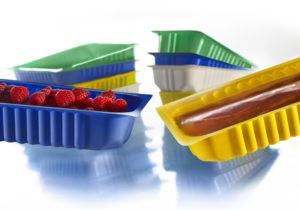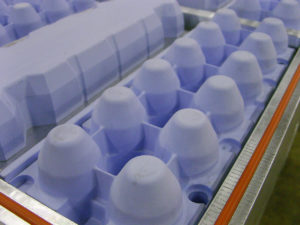More than 90% of all thin-gauge thermoformed parts are formed with plug-assisted pre-stretching. Conor Carlin of CMT Materials outlines the basics of plug material science and practical steps that thin-gauge thermoforming converters (and their moldmakers) should follow to optimise plug design. A Packaging MEA special

While specific plug designs are dictated by many factors including depth of draw, the number of mold cavities, the required wall thick- ness of the final part, and the stretching characteristics of the plastic, there are certain fundamental techniques that can help improve the repeatability of the forming process as they relate to the plug assist.
Before examining the specific details of each step, it is important to point out that the user’s perspective plays an important role in this process. Depending on whether you are a thermoformer, toolmaker, or both, there are several elements to consider when choosing the right material. Simply put, some people have to design and build the plugs while others have to run the machines that are equipped with those plugs. In other cases, the same company is doing both. This is an important distinction when considering the thermoforming ecosystem which includes resin suppliers, extruders, converters, toolmakers, machine shops, and OEMs. Changes in one part of the ecosystem affect decisions and outcomes in another. If a toolmaker simply selects one grade of material without under- standing the interaction between the plug and the plastic, the processor might not be getting the best material for that project.
Material selection
Not all plug materials are created equal. Solid polymers and syntactic foams are most commonly used in global thin-gauge applications. For example, there are different grades of syntactic foam which are optimised for performance with different types of plastic, temperature, machining conditions, surface finish, durability, and price. It is not always advisable to simply use the same material as last time if other variables have changed. The processing parameters for multi-layer films such as PP/EVOH/PE are certainly different than HIPS.
It is important to recognize that different plug materials have different physical properties. This is most dramatically seen when designers are switch- ing from nylon, POM, or acetal plugs to syntactic plugs. When we think about CLTE in relation to plug assists, the problem is a bit more complex. Solid polymers, by their very nature, have a relatively high CLTE. They like to grow when heated and change greatly during the plug assist thermoforming process as they absorb heat from the sheet during contact. Growth in the plug impacts how much plastic is stretched and ultimately makes thermoformed parts thinner and more uneven. This leads to weaker parts with lower top load strength, problematic for stacking and shipping. The alternative is to increase material gauge, an expensive proposition that basically “gives away the store” in terms of profit margins.
Syntactic foams are filled with hollow glass spheres, so even though they are polymeric in nature, the stable fillers mean that the CTLE is relatively
low, around 18 – 22 x 10-6 in/in/°F (32 – 39 x 10-6 m/m/°C). When you couple this with the fact that syntactic are excellent insulators and therefore take less heat from the sheet and run at much lower operating temperatures, you have a material that maintains a much higher dimensional stability that other plug material types. With more stable materials, the thermoforming process itself becomes much more stable.
In addition to CLTE, plug material strength (as measured by flexural toughness according to ASTM D790) can play an important role in design. It is important to choose a material that will meet thermoformed part strength requirements.
For example, if the plug has narrow ribs or posts, it is not a good idea to use a brittle material like some epoxy syntactic.
Plug Design & Material Together
Plug design is a complex issue involving many factors. Plastic sheet choice, mold design, process temperature, thermoforming equipment, plug material choice, and more all play a variable role. The best practice approach is to begin with a “material safe” plug design. This means that the plug material should be as close to the cavity wall and floor as possible (commonly 1.5mm) with a minimal radius at the nose of the plug. This allows for an increase in radius if too much material is carried to the base of the cavity. More plug taper can also be added to distribute material thick- ness evenly or to remove potential plug marks.
The intent of the plug is to pre-stretch and distribute plastic to the proper places. The initial interface point between the plug and the plastic will carry the greatest amounts of material. Sharp edges mean there will be less flow of plastic, resulting in thinner side walls and thicker base/ corners. Round edges mean there will be more flow of plastic resulting in thicker side walls and thinner base/ corners. Different mold designs, machine features, plastic sheet characteristics, plug speed, vacuum venting/timing, and even operator techniques affect the performance of the plug.
Understanding machining guidelines
Like many advances in material science, new tools are required for new materials. In the case of plug assists, traditional or legacy materials such as wood or commodity polymers are easily understood by CNC operators. Syntactic foam is a combination of hollow glass microspheres and thermoset or thermoplastic binder systems. The cutting mechanics are inherently different. Two key conditions must be met to get the best possible results: sharp cutting tools and adequate feed rates.
Cutting tools must be sharp to obtain a satisfactory surface finish when machining syntactic foam. Dull cutters or incorrect geometries will result in poor surface conditions. High-speed steel cutters are quickly dulled. Through research with tool manufacturers, CMT has found that solid carbide cutters with high-helix geometry are preferred due to the sharp edge and long life that is possible.
Modify the plug surface
There are different schools of thought on how to modify the plug surface. Most agree, however, that polishing the plug will result in a more repeatable process. Silicon carbide sandpaper is commonly used. When polishing thermosets and co-polymer syntactic plugs, the sand- paper can be dipped in water. This helps reduce the build-up of dust in the grit. It should be noted that this method cannot be used for thermoplastic-based syntactics. Liquids will actually roughen the surface during the polishing process. Scuff pads and open mesh or micro-mesh sandpaper can also be used as they too reduce the amount of dust or build-up in the grit.
Temperature, substrate, surface finish, motion, dust, and many other factors affect the plug/ sheet interface. Different surface conditions due to the machining or polishing of a plug material, or even a few degrees of temperature variation in a mold, will affect the coefficient of friction (CoF) and sheet stretch values. The value changes for each specific plastic relative to plug material and even from roll to roll of plastic. There is both a static (objects at rest) value and a kinetic (objects in motion) value for the frictional coefficient. The only suitable method for determining a CoF value is experimentation with the actual plug and sheet.
Economics of selecting plug assist
Recently, CMT concluded the first phase of a multi- phase collaborative field trial with industry partners. The primary goal of these experiments was to isolate the plug material as a variable in the forming process. Of course, many variables are interrelated, but when asking “how much is 25 micron worth”, we wanted to explore the impact that a simple plug material change would have.
We used a statistical approach to analyze the impact of 7 different materials and 2 conditions, “baseline” and “optimized” on part thickness uniformity. There were 45 thickness measurement points on the formed part. All plugs had the same geometry. “Baseline” and “optimized” describe the machine and tool conditions at the start of a run (baseline) and at the point where accept- able parts were produced (optimized). The part in question was a square, clarified PP deli tub.
Conclusion
The plug is an integral and critical component of a thermoforming project. It
is the one element in the process that impacts the product shape, material distribution, clarity, and crush strength at the same time – all while the plastic is still in a transitional state.
Thermoforming is notoriously filled with variables that cannot always be controlled. It is important to conduct a full comparison of the plug material costs and the trade-offs in material distribution, part weight, rejects, and other concerns such as aesthetic quality. With careful planning and adherence to best practices, crafting the right plug assist can put you on the path to high-quality, repeatable parts.
(Conor Carlin is the sales and marketing manager for CMT Materials, USA)




